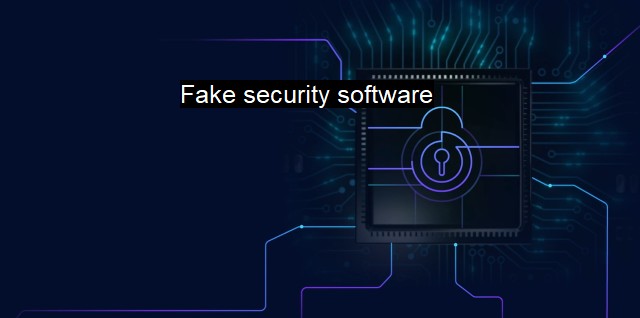What is Fake security software?
The Reality of Fake Security Software in the Cybersecurity Landscape: Identifying the Harmful Impacts and Safeguarding against Rogue Antivirus Programs
"Fake security software" , also commonly known as "scamware", "rogue security software", or "fraudware", refers to malicious software that dupes unsuspecting users into believing their computer system is at high risk of a virus or malware attack. The key intents behind the creation of this phony security software are either to coax users into making unnecessary payments for non-existent threats or directly compromising the cyber integrity by facilitating the surreptitious installation of unjustifiable harmful applications.Understanding this security concern forms a critical matter in the field of cybersecurity and antivirus. Needless to say, the era we live in is characterized by significant reliance on computing systems, inducing a surge in the instances of cyber-attacks. Cybersecurity and antivirus applications have shaped up as the compelling shields against these unwanted cybercrimes. with the creation of fake security software, these shields themselves become threats they were designed to guard against.
The mechanism of fake security software is nuanced, employing thoroughly thought-out strategies aimed at duping the user. The story typically starts with a superficially genuine-looking popup alert on the user's computer, triggering panic with fabricated messages about a detected virus or a slew of malware infections. In several instances, these alerts might mirror the look of legitimate antivirus software, creating an illusion of authenticity. Redirectsters are of particular worriment, as they impulsively reroute users to sham websites endorsing fake antivirus products.
The trickery circulates around coercing users into buying full versions of non-existent software to remove detected threats. Normally, pushing the alert's “Remove All” or similar buttons leads to a prompt requiring the user to purchase a specific software. In return, they are assured of complete ‘cleaning’ through this alleged software's services. no real cleaning is done. The real threat may even lurk unnoticed as the fear of the reported, but non-existent threat, consumes the user's attention.
Some more sinister variants install malicious software on the user’s system. The malware acts discreetly in the shadows while the user feels falsely reassured by the fake software’s supposed protective scanning. Through this planted malicious software, hackers can gain control over the system, steal sensitive information, corrupt data, damage system integrity, or propagate further cyber threats using the infected system as a vector.
From the perspective of cybersecurity, understanding and countering these threats mandate a blend of knowledge and vigilance. One should comprehend that reputable antivirus and cybersecurity brands rarely deploy pop-ups, and if they do, they never advertise in a fear-provoking manner or pressurize the user into immediate purchase or upgrading. Legitimate software relies on periodic automatic or user-manual system scans rather than random instant danger detection probes. A solid comprehension of these strategy differences forms the first line of defense against scamware.
Indeed, fake security software has emerged as a pertinent concern manipulating the very mechanism designed to safeguard online operations. Further repercussions could even include degrading the public trust in legitimate security software. Hence, it becomes incredibly important to stay educated about the mechanisms of such software, and more importantly, to cross-verify the authenticity of security alerts & addresses from where these inoculate.
Conclusively, addressing this deceptive menace calls for a collective effort, involving the general user community's awareness, effective counter-strategies by genuine antivirus vendors, and escalated efforts by cybercrime combating agencies. As we move toward an increasingly connected world, safeguarding against threats like fake security software is no longer a matter of option but a cyber-hygiene essential.

Fake security software FAQs
What is fake security software?
Fake security software, also known as rogue antivirus or scareware, is a type of malware that poses as legitimate antivirus software. It is designed to trick users into believing their computer is infected with viruses or malware, and then convince them to pay for a fake antivirus program that promises to remove the non-existent threats.How does fake security software infect my computer?
Fake security software can be installed on your computer through a variety of methods, such as malicious downloads, fake updates, or email attachments. It can also be installed by other malware that has already infected your computer.What are the risks of using fake security software?
Fake security software is not only a waste of money, but it can also put your computer and personal information at risk. It may contain malware or spyware that can steal your personal data or damage your computer. Additionally, it may disable your legitimate antivirus software, leaving your computer vulnerable to real threats.How can I protect myself from fake security software?
To protect yourself from fake security software, it is important to have a reputable antivirus program installed on your computer. You should also be cautious when downloading software or clicking on links, especially from sources you don't trust. It is also a good idea to keep your operating system and antivirus software up to date with the latest security patches.| | A | | | B | | | C | | | D | | | E | | | F | | | G | | | H | | | I | | | J | | | K | | | L | | | M | |
| | N | | | O | | | P | | | Q | | | R | | | S | | | T | | | U | | | V | | | W | | | X | | | Y | | | Z | |
| | 1 | | | 2 | | | 3 | | | 4 | | | 7 | | | 8 | | |||||||